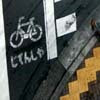I'm pretty sure one of the things behind the discourse in Documentaries is the easy push button for viewer recognition. Using short-cuts of wide-spread held images of the concepts or place being addressed to communicate information, instead of focusing on the reality of these images, or addressing their high levels of constructed meaning. In a way it is a cheap shot used to communicate to the audience, either a sense of place, time, or object, or as a dramatic, interest creating ploy to make the viewer watch by playing on the long-held discourse of Asia as exotic, distant, intriquing, interesting. If the place is exotic, we want to learn more about the 'strange, foreign ways'. However, not all documentaries use these sorts of ploys. There are also political factors, such as the sensitivity of the Atom Bomb, the American Occupation, etc that for an American audience may be elided or not mentioned in a sort of memory open space. I haven't decided how much of this seems to be a sort of political pressure in not wanting to create a controversy that may prevent the documentary from showing (since we are talking about public television), or not wanting to bring up or get into often complicated issues. (Am I giving too much credit there?)
//edit
There seem to be certain dominant aesthetiques in (recent, public television, focused) documentary on Japan--there is the super pop tech bright light, there is the old style jidaieki drama style, and then the more straightforward 'is as is' style.
///Edit
Also, how much of the aesthetique is appropriation of existing aesthetic in the culture viewed to create Theme in the documentary, how much is use of inner cultural signs for the topic, and how much is just cheese?
Subscribe to:
Post Comments (Atom)

No comments:
Post a Comment